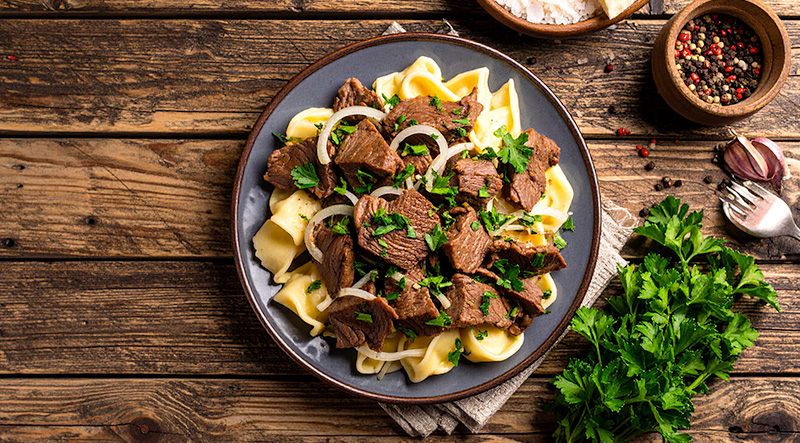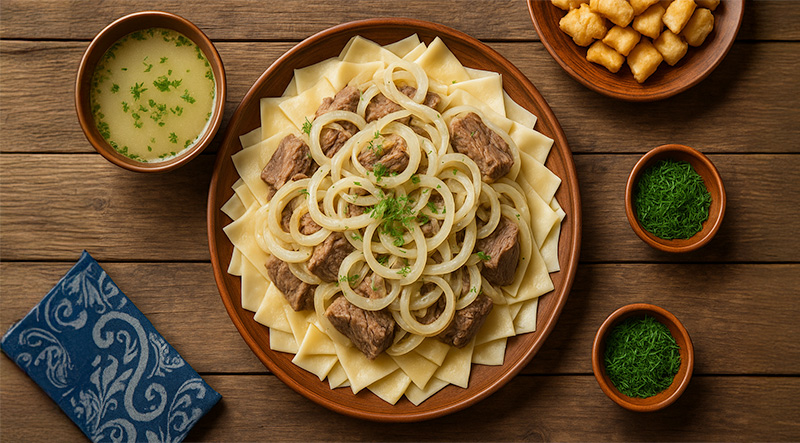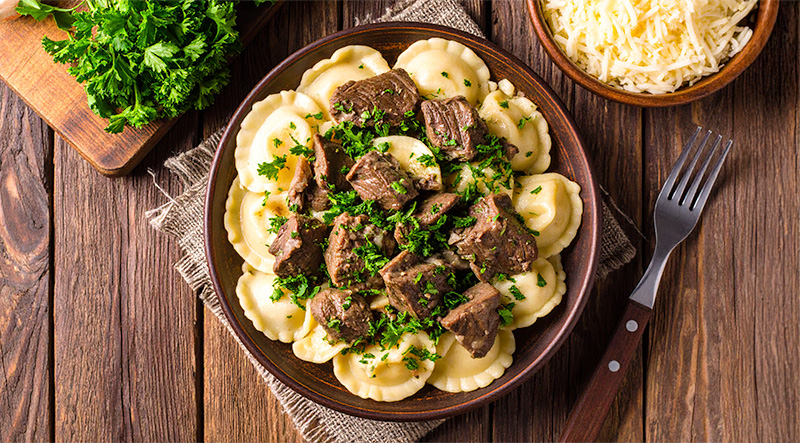Beshbarmak is the staple of Kazakh cuisine and the ultimate comfort food of the steppe. It is hearty, modest, and rich in tradition. This Kazakh national dish, which translates to "five fingers" in reference to the tradition of eating it by hand, consists of soft, boiled meat (typically lamb, beef, or horse) atop broad, smooth noodles, topped with soft-cooked onions and a dash of flavorful broth. This dish, which reflects Kazakhstan's nomadic past, is meant to be shared, celebrated, and told over a single platter of rich, rustic flavor. You can taste centuries of tradition in just one bite. Read More...
The History of Kazakhstan’s National Dish – Beshbarmak:
Beshbarmak, the national dish of Kazakhstan, is far more than just a comforting plate of noodles and meat—it’s a time-honored symbol of the Kazakh nomadic spirit, a dish steeped in tradition, unity, and cultural pride. Literally meaning “five fingers” in Kazakh, Beshbarmak is traditionally eaten by hand from a large communal platter, bringing people together in a way that transcends words and honors hospitality above all.
Nomadic Roots and Resourcefulness:
Kazakhstan’s history is deeply linked to the nomadic lifestyle of the steppes. For centuries, Kazakh tribes moved with the seasons, living in yurts and relying on their herds for sustenance. This mobile way of life required food that was nourishing, easy to prepare, and made from available ingredients—particularly horse, lamb, or beef, which were highly valued livestock.
Beshbarmak was born from this environment. It featured boiled meat, typically horse meat (kazy, a type of horse sausage, being a prized delicacy) or lamb, served with freshly made flat noodles and often accompanied by a rich, savory onion broth (sorpa). The preparation was straightforward, but the meaning and ritual surrounding the dish were deeply significant.
A Dish of Respect and Ceremony:
Beshbarmak is most often served at important gatherings, including weddings, funerals, births, and state celebrations. The dish is more than nourishment—it is a form of honoring guests, showcasing Kazakh values of hospitality, generosity, and communal strength.
The traditional way to serve Beshbarmak is on a large round wooden platter or dish, with the meat chopped into pieces and laid over wide sheets of boiled dough (similar to pasta). Stewed onions are layered over the meat, and the entire dish is ladled with hot broth. The head of the household or elder often performs the ceremonial cutting of the meat, distributing specific pieces according to tradition, with each part holding symbolic meaning.
Regional Variations Across the Steppes:
While the heart of Beshbarmak remains consistent, regional variations across Central Asia exist. In Kyrgyzstan, Uzbekistan, and Turkmenistan, similar versions exist under different names like norin or tuzlama, often using different meats or spices. In Kazakhstan, horse meat remains the most traditional and culturally esteemed, though beef and lamb are more common today for everyday meals.
Modern versions might include garlic, herbs, or a clearer broth, and in urban areas, the dish is often served with flatbread, salads, or boiled potatoes. Still, the essence of the dish—a warm, hearty celebration of Kazakh identity—remains unchanged.
Beshbarmak in Contemporary Kazakhstan:
Today, Beshbarmak is proudly served in restaurants, homes, and festivals throughout Kazakhstan. It is a source of national identity and an anchor in the country’s rich culinary landscape. Whether made for a small family dinner or a grand feast of hundreds, it continues to play a vital role in cultural expression and social cohesion.
It is not unusual to see Beshbarmak served alongside toasts, music, and stories—often with participants gathered cross-legged around a low table, sharing laughter and tradition in equal measure.
More Than a Meal: A Heritage on a Plate:
In every steaming platter of Beshbarmak lies the spirit of the Kazakh steppe—its resilience, its unity, and its generosity. It’s a dish that has traveled across generations, adapting to modern life while carrying the stories of ancestors in each bite. For Kazakhstan, Beshbarmak isn’t just the national dish; it’s a living expression of history, hospitality, and cultural pride.
Boil the Meat:
Make the Dough (Noodles):

Cook the Noodles:
Prepare the Onion Topping:

Assemble the Dish:
Serve with Broth:

Tips:
The total preparation and cooking time for Beshbarmak is approximately 2.5 to 3 hours. Preparing the meat for boiling and skimming takes around 15–20 minutes, followed by 2 to 2.5 hours of simmering to achieve tender, flavorful results. While the meat cooks, the dough is prepared and rested for about 30 minutes, then rolled out and cut into noodles, which are cooked in just 5–6 minutes. Preparing the onion broth and assembling the dish adds another 15–20 minutes. Much of the time is passive, making Beshbarmak a slow-cooked but manageable and rewarding traditional meal.
A single serving of Beshbarmak, based on the traditional recipe provided, contains approximately 600–800 calories, depending on portion size and specific ingredients used. The boiled meat (lamb, beef, or horse) contributes about 250–350 calories per serving, while the homemade noodles made from flour and egg add around 200–250 calories. The onion broth (sorpa) and any added clarified butter or oil contribute an additional 50–100 calories. Optional items like kazy (horse sausage) or fried dough sides (baursak) can increase the total significantly. Overall, Beshbarmak is a hearty, protein-rich, and energy-dense dish ideal for communal feasting or special occasions.







